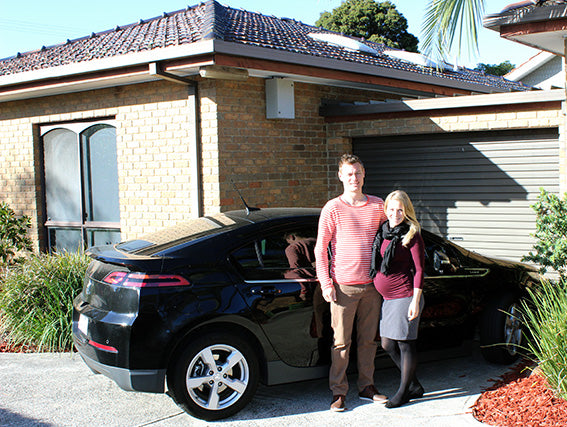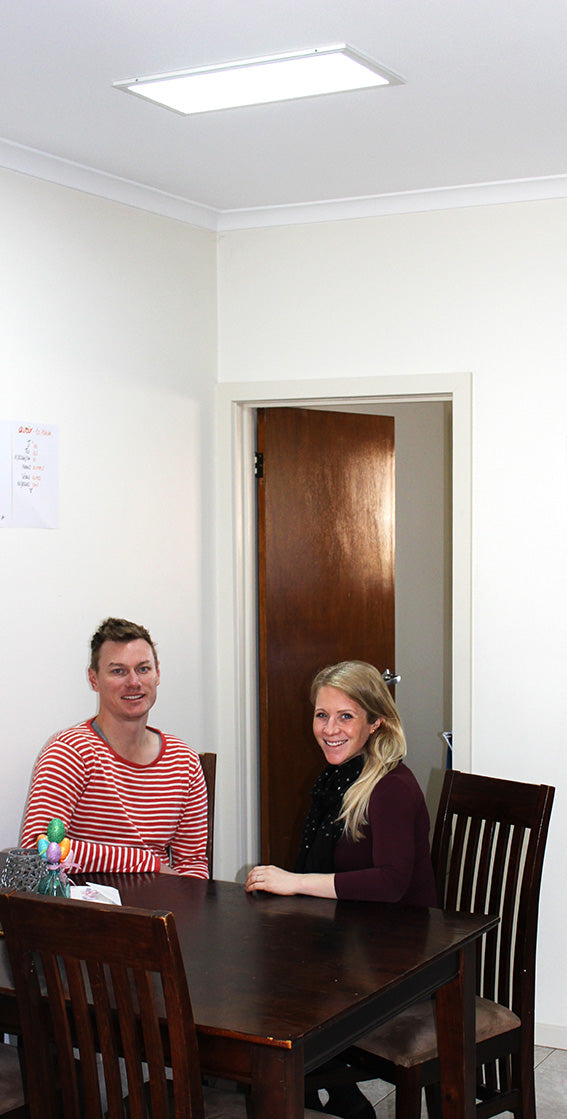This case study shows how rental tenants can make big improvements to the warmth and comfort of their home, through an agreement with their landlord to install things like ceiling insulation, LED lighting, and other energy efficiency measures.
Typical rental properties tend to rate very poorly for thermal comfort and energy efficiency, and usually it can be hard to significantly improve this if you are part of the one-third of Australians who are renting.

Tenants Jaron and Caz with their Holden Volt electric car
While there is quite a bit you can do that is temporary and behaviour based, the biggest gains to be made are in the infrastructure of the building itself. This is the landlord’s responsibility and can require a decent upfront investment, which will typically take several years to pay back financially. There are few obvious financial incentives and no comfort incentive for owners who aren’t living on the property. Meanwhile the tenants can have issues with getting permission and not staying long enough to see financial returns on investment if they were to pay the upfront costs themselves.
All is not lost however, there are ways for the landlord and tenants to work together to improve a property that works out for everyone. The EnviroShop was approached in late 2015 by Jaron and Caz to discuss costs and benefits of retrofitting their rental property to be more comfortable and energy efficient. We discussed their experience of living in the property for the last 12 months, looked at some sketches of the floor plan, photos, and satellite images on the internet. Then we made a list of suggested improvements and a quote so they could approach their landlord.
The grand total for all suggestions, including professional installation by appropriate tradespeople, was around $5,000.
How did it get paid for? In the tenants words:
“We were prepared to move out after suffering though a not-so-cold winter, but the prices of any places big enough were at least $100 more per week in rent. We figured that we were happy enough to pay another $50 to not bother moving (as the other places were actually nicer) and that we could see ourselves here for another two years. That gave us a rough budget of $5000. Then speaking to the EnviroShop gave us a rough quote without annoying any tradies.
In terms of paying for it, we proposed two options:
Since the landlord can claim the works in their tax we assumed a 37% discount (income $80-180k) leaving roughly a $3200 bill. We offered to either:
- [A] pay him the $3200 in a lump sum up front but keep our rent at our current rate (better for us) or
- [B] we simply pay the extra $50/wk.
He chose option B.
Learnings
– The closer to tax time the better for the landlord
– Without an energy-rating standard the landlord needs to accept our increased rent because if we move out early they are somewhat guaranteed the new rental amount (we keep paying it until someone else does)
Hopefully even after the payback period the place continues to bring in a higher yield for the landlord or we might even stay longer. While negative-gearing is still around take advantage is my advice!”
So what improvements did we make?
Draught-proofing – we determined that draughts were a big factor in the house during both summer and winter, so suggested some door and window weather stripping for the tenants to install themselves.
Ceiling insulation – there was some very old insulation in the ceiling that was providing little benefit, so we organised our insulation installer to visit for a quote.
Reducing summer heat load – a dark coloured tile roof was gaining significant heat in summer, so we suggested a solar powered roof ventilator to actively extract the built up heat. There was significant solar gain from some windows in summer, so we suggested Renshade reflective shielding.
Lighting upgrades – the lighting in the house was providing very little light while using significant amounts of energy, and the house was very dark in winter, so we suggested installing an Illume solar powered skylight and replacing most of the current light fittings with new LED fittings.

Solar panel for skylight, and solar roof ventilator
How has it turned out?
After negotiating with their landlord all of these suggestions were given the go-ahead. We organised supply and install of the quoted items and the installations were performed over about two weeks.
In the tenant's words: “Tradies were great, nice guys and quick operators.
House now holds a temperature much better – one hot day didn’t heat the place up and the cooler days aren’t being felt at all.
The Solar Skylight has changed our lives. It keeps our body clocks in check and ensures we don’t find ourselves all gloomy on darker days. We’re more productive I think too.

Oyster lights are much nicer than the spot lights we had before. I’ve now changed the outside sensor light from 300W of halogen to 60W of LED.
The insulation has been noticeable. When the heater goes on, it’s stays warm. On hot days it’s cool inside (I think the solar powered roof ventilator is helping a lot there too).”
It is hard to put a dollar value on comfort in a home, but the savings on energy bills will be significant, overall providing a good payback for the extra $50/week in rent.
These improvements have left the landlord with minimal out of pocket expenses in the short term and a long term higher rental income, happier tenants who will stay on longer, reducing advertising costs etc and a house that will rate higher (and hopefully attract higher rent) if the Government ever gets around to implementing the rumoured compulsory rental property energy rating scheme.
Summary of improvements made:
- Old ineffective insulation removed, roof cavity cleaned, new R3.5 Polyester Solutions Batts installed
- Kimberley Solar Roof Ventilator installed
- Solar Skylight installed
- Renshade reflective window covering and Raven door and window weather stripping provided for tenants to install
- 7 existing light fittings replaced with LED Oyster fittings. Old fittings were mostly GU10 halogen spotlights.
